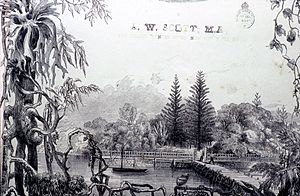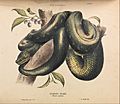Helena Scott facts for kids
Quick facts for kids
Helena Scott
|
|
|---|---|
 |
|
| Born | 11 April 1832 |
| Died | 24 November 1910 (aged 78) Harris Park, NSW, Australia
|
| Other names | Helena Forde |
| Known for | Natural history illustration |
| Spouse(s) | Edward Forde |
| Parent(s) |
|
| Relatives | Harriet Morgan (sister) |

Helena "Nellie" Scott (1832–1910) was an Australian artist. She was famous for her detailed drawings of nature. Helena also collected plants for scientific study.
She and her sister, Harriet Morgan (1830–1907), were very talented. Their father, Alexander Walker Scott, was an expert on insects.
Life on Ash Island
In 1846, Helena's family moved from Sydney to a place called Ash Island. This island was in the Hunter River estuary, near Hexham. It was a wild area full of native plants and animals.
Helena and Harriet grew up learning from their artistic father and their mother, Harriet Calcott. For about 20 years, they lived on the island. They spent their time drawing and writing about its plants and wildlife. They especially focused on butterflies and moths.
The sisters kept very careful records of their work. In 1862, they made a handwritten list called "The Indigenous Botany of Ash Island." This list described their well-preserved plant samples. Their amazing drawings and notes about the island's moths and butterflies show how dedicated they were.
Helena and Harriet worked closely with their father. They would collect live insects from around their home. Then, they would find the right plants to feed these creatures. They also wrote letters to scientists to help identify new species. Their father always gave them credit for their excellent drawings. He praised how well they showed insects at every stage of their lives.
The 1860s were a tough time for Helena. Her mother passed away, and her father faced money problems. Helena's husband, Edward Forde, whom she married in 1864, also died. Because of these challenges, the family had to leave Ash Island.
The sisters then needed to earn money from their art. Harriet once asked for payment for some bird egg drawings. She wanted it to be a secret that she was being paid. Harriet later married Dr. Cosby William Morgan in 1882. Helena, who was a widow, continued to struggle financially. Both sisters kept illustrating professionally for the rest of their lives. Harriet drew plants for "Railway Guide to New South Wales" books. Both sisters also helped create Australia's first Christmas cards in 1879.
Helena Scott passed away in Harris Park in 1910. She did not have any children.
Amazing Nature Artists
By 1864, Helena and Harriet had finished many drawings of moths and butterflies. These were used in the first book of their father's Australian Lepidoptera and Their Transformations. This work led to more art jobs for the sisters. Some jobs came from their father's friends at the Australian Museum.
They drew pictures for James Charles Cox's book, Monograph of Australian Land Shells (1868). They also illustrated Gerard Krefft's Snakes of Australia (1869) and Mammals of Australia (1871). Their artwork in these books was highly praised at the Sydney Intercolonial Exhibition in 1870.
About ten years before, a famous nature expert named William Swainson saw their paintings. He wrote in The Sydney Morning Herald: "These drawings are as good as any I have ever seen by modern artists." He added that "every tuft of hair in the caterpillar, the silken webs of the cocoon, or the delicate and often intricate pencillings on the wings of a moth, stand out with a prominence of relief."
The bright colors and careful details in their art show how patiently they observed nature. These drawings are still beautiful even after 150 years. The Australian Museum bought 100 of their finished drawings for £200 in 1884. Because of their excellent work, Helena and Harriet were made honorary members of the Entomological Society. This was a very special honor for women at that time.
The Australian Museum later decided to publish the rest of the insect material. They had bought it in 1884, along with the sisters' drawings, diaries, and notes. Helena helped supervise this project. She worked with museum entomologist Arthur Sidney Olliff. The second volume of the Lepidoptera was published in five parts between 1890 and 1898. The two sisters did most of the lithography for this book. It was printed by the Australian Museum and then sent to England to be colored by hand. The sisters' original paintings were used as guides for the colors.
Helena and Harriet were mostly forgotten until 2011. That year, the Australian Museum in Sydney held an exhibition called Beauty from Nature: Art of the Scott Sisters. This exhibition brought their amazing work back into the spotlight.
A street in Canberra, Forde Place in the suburb of Chisholm, is named in Helena's honor.
Plant Discoveries
Helena and her sister also collected plants for a famous botanist named Ferdinand von Mueller. In return, he gave them names for the plants they drew. Helena's collections include important plant samples. These samples helped scientists name new species like Kochia sedifolia, Diospyros pentamera, Atriplex stipitata, and Poa fordeana.
Gallery









